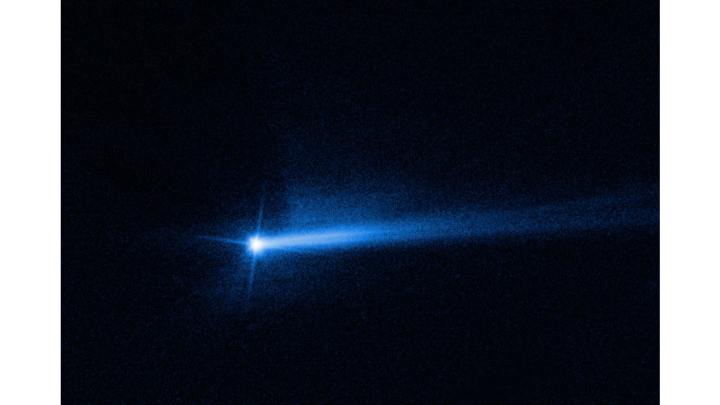A few weeks ago NASA’s DART mission succeeded in changing the orbit of the Dimorphos asteroid in a first-of-its-kind test of potential planetary defense systems. The DART spacecraft deliberately crashed into the asteroid and the impact was observed by telescopes around the world, including the James Webb and Hubble space telescopes. Now, follow-up observations from Hubble show a surprising finding: the asteroid now has a second tail.
Such tails are more commonly associated with comets (made of ice and dust) than asteroids (made primarily of rock). As comets typically travel around the sun in elliptical orbits, they come closer to the sun at some times than at others. As a comet approaches the sun, it heats up and gives off dust and gas which forms a distinctive tail. In the case of the Dimorphos asteroid, the tails are composed of material thrown up by the DART impact called ejecta.
Two tails of dust ejected from the Didymos-Dimorphos asteroid system are seen in new images from NASA’s Hubble Space Telescope, documenting the lingering aftermath of NASA’s Double Asteroid Redirection Test (DART) impact. SCIENCE: NASA, ESA, STScI, Jian-Yang Li (PSI) IMAGE PROCESSING: Joseph DePasquale
The first tail from Dimorphos was observed a few days after the initial impact on September 26 as debris was left behind the asteroid. But as Hubble continued to observe the asteroid with a series of 18 observations, researchers saw a second tail form between October 2 and October 8.
“Repeated observations from Hubble over the last several weeks have allowed scientists to present a more complete picture of how the system’s debris cloud has evolved over time,” Hubble scientists write. “The observations show that the ejected material, or ‘ejecta,’ has expanded and faded in brightness as time went on after impact, largely as expected. The twin tail is an unexpected development, although similar behavior is commonly seen in comets and active asteroids. The Hubble observations provide the best-quality image of the double-tail to date.”
As this is the first time such an impact has been observed, there is a lot we still have to learn about the long-term effects on the asteroid and its orbit. Researchers will continue to look at the Hubble data on the asteroid to gather more information about it, and the European Space Agency will launch its Her mission in 2024 to visit the asteroid system and see the effects of the impact up close.
Editors’ Recommendations
